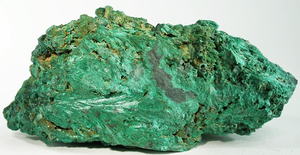Difference between revisions of "Ore"
(→Meaning) |
|||
| Line 2: | Line 2: | ||
===Meaning=== | ===Meaning=== | ||
[[File:Malachite.png|right|300px|thumb|This is a [[Copper]] [[ore]] called [[Malachite]] which has the [[Chemical Formula]] Cu<sub>2</sub>CO<sub>3</sub>(OH)<sub>2</sub>.]] | [[File:Malachite.png|right|300px|thumb|This is a [[Copper]] [[ore]] called [[Malachite]] which has the [[Chemical Formula]] Cu<sub>2</sub>CO<sub>3</sub>(OH)<sub>2</sub>.]] | ||
| − | An [[ore]] is [[rock]] that has a large enough amount of a [[mineral]] to be worth [[Extraction of Metals|extracting]] the [[metal]] from that [[mineral]]. | + | An [[ore]] is a [[rock]] that has a large enough amount of a [[mineral]] to be worth [[Extraction of Metals|extracting]] the [[metal]] from that [[mineral]]. |
===About Ores=== | ===About Ores=== | ||
Latest revision as of 13:47, 27 February 2022
Contents
Key Stage 3
Meaning
An ore is a rock that has a large enough amount of a mineral to be worth extracting the metal from that mineral.
About Ores
- Ores are found in different places on the Earth's Crust.
- All rocks have minerals in them but most do not have them in a large enough fraction to be worth the money it would take to extract a metal from them.
Key Stage 4
Meaning
An ore is rock that has a large enough amount of a mineral to be worth extracting the metal from that mineral.
About Ores
- An ore may be referred to as a low grade ore which contains a small percentage of the mineral by mass or a high grade ore which contains a high percentage of the mineral by mass.
- The grade of an ore determines whether it is worth the cost and effort to extract the mineral.
- Low grade ores are usually extracted using phytomining or bioleaching which are cheap but take a long time.
References
AQA
- Ore, pages 132-3, GCSE Chemistry; Student Book, Collins, AQA
- Ores, page 137, GCSE Combined Science Trilogy; Chemistry, CGP, AQA
- Ores, page 162, GCSE Chemistry, CGP, AQA
- Ores, page 208, GCSE Combined Science Trilogy 1, Hodder, AQA
- Ores, pages 106, 1256, GCSE Chemistry, Hodder, AQA
- Ores, pages 199, GCSE Combined Science Trilogy 2, Hodder, AQA
- Ores; bauxite, page 119, GCSE Chemistry, Hodder, AQA
- Ores; metal extraction, pages 220-1, GCSE Combined Science Trilogy 1, Hodder, AQA
Edexcel
- Ores, page 117, GCSE Combined Science; The Revision Guide, CGP, Edexcel
- Ores, page 155, GCSE Chemistry, CGP, Edexcel
- Ores, page 55, GCSE Chemistry; The Revision Guide, CGP, Edexcel
- Ores, pages 88-89, GCSE Chemistry, Pearson, Edexcel
